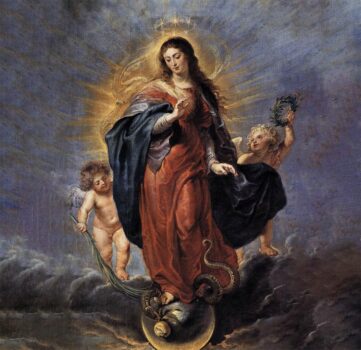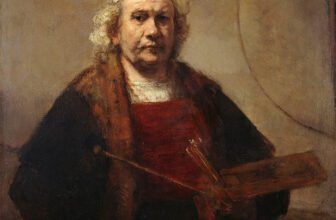A Deep Meaning of Peter Paul Rubens’ “Immaculate Conception” Painting
Few paintings in the vast canon of Christian art strike the perfect balance between theological depth, stylistic grandeur, and symbolic richness like Peter Paul Rubens’ “Immaculate Conception”. Painted during the Baroque era, this masterwork is a striking visual representation of a profound theological doctrine, conveyed through the brilliant mind and skillful hand of one of the most celebrated painters in Western art history.
In this post, we delve into the historical context, symbolism, artistic style, and spiritual meaning behind Rubens’ “Immaculate Conception”, uncovering the layers of theological and visual storytelling that make this painting a timeless marvel.
Who Was Peter Paul Rubens?
Peter Paul Rubens (1577–1640) was a Flemish Baroque painter whose influence defined an entire era of European art. He was not only a master painter but also a diplomat, scholar, and humanist. His works are celebrated for their sensuality, movement, rich coloration, and allegorical complexity. Rubens was deeply religious and created numerous religious paintings that merged Counter-Reformation ideology with dazzling visual spectacle.
His studio in Antwerp became a magnet for talent and an epicenter for some of the most ambitious religious commissions of the 17th century. Among his sacred themes, the Virgin Mary held a special place, symbolizing divine grace, purity, and intercession. It is within this context that Rubens’ “Immaculate Conception” takes its place.
What Is the Immaculate Conception?
The term “Immaculate Conception” refers to the Catholic dogma that the Virgin Mary was conceived without original sin, preserving her from the stain of human fallenness from the very beginning of her life. This doctrine, while only officially defined by Pope Pius IX in 1854, had been widely accepted and promoted in Catholic theology for centuries, particularly during the Counter-Reformation period in which Rubens painted.
The Immaculate Conception celebrates Mary’s unique sanctity, her role as the “New Eve,” and her worthiness to become the mother of Jesus Christ. Artists of the time sought to visualize this complex idea through layers of symbolic imagery, and Rubens, always one for grandeur and theological subtlety, rose to the challenge magnificently.
When, Where, and How “Immaculate Conception” Was Created
Rubens’ “Immaculate Conception” was painted around 1628–1629 during a period of prolific output. It was likely commissioned by a religious institution in Spain, a country deeply devoted to Marian theology, especially the Immaculate Conception doctrine, long before its formal declaration.
The painting is part of a broader movement of Marian devotion that spurred countless commissions from the Church to reaffirm doctrinal teachings through art. Rubens, who had been exposed to Italian and Spanish masters, synthesized various influences, including Titian, Michelangelo, and El Greco, into his unique Flemish-Baroque idiom.
Today, the painting is housed in the Museo del Prado in Madrid, Spain, among other Rubens masterpieces. The Prado, one of the world’s most prestigious art museums, recognizes Rubens as one of the leading figures of the Baroque age, showcasing the deep ties between Flanders and Spain during the Habsburg reign.
What Is Happening in the “Immaculate Conception”Painting?
Rubens’ “Immaculate Conception” is an ethereal, vertically oriented composition that brings the viewer’s eye heavenward. At its heart is the Virgin Mary, depicted as an idealized young woman clothed in celestial garments. She stands on a crescent moon, a symbol deeply associated with Marian iconography, referencing Revelation 12:1: “A woman clothed with the sun, with the moon under her feet.”
Mary is bathed in divine light, surrounded by cherubs and angels who lift her gaze upward. Her hands are folded in prayer, her head tilted in humility and grace. The background is aglow with a golden hue, suggesting the radiance of divine presence.
The lower half of the painting is rich with symbolism: a serpent crushed under Mary’s foot, referencing her role as the conqueror of sin; roses and lilies, symbols of purity; and mirror, palm branches, and enclosed gardens, drawn from the Litany of Loreto, a traditional Catholic prayer full of metaphors for Mary.
Symbolism and Meaning
Rubens’ “Immaculate Conception” is a treasure trove of Christian symbols that together create a visual hymn to Mary’s sinless nature.
1. The Crescent Moon
As mentioned, the crescent moon beneath Mary’s feet is taken from Revelation 12:1. It symbolizes both her purity and her victory over darkness, as the moon reflects the light of the sun just as Mary reflects divine grace.
2. The Serpent
Mary is depicted crushing a serpent underfoot, signifying her triumph over original sin and evil. This draws from Genesis 3:15, where God tells the serpent that the seed of the woman will crush his head. In Christian tradition, this “woman” is often interpreted as Mary.
3. The Garden and Enclosed Space
The “Hortus Conclusus”, or enclosed garden, is a symbol of Mary’s virginity and immaculate nature. This is another traditional metaphor that harks back to the Song of Songs in the Old Testament.
4. The Mirror
The mirror symbolizes Mary as the “speculum sine macula” or “mirror without blemish,” emphasizing her perfection and sinlessness.
5. Lilies and Roses
Lilies signify purity and virginity, while roses denote divine love and her spiritual beauty.
6. The Angels
The heavenly host surrounding Mary elevates the painting’s spiritual tone. The cherubs, with their joyful expressions and luminous energy, underscore her exalted position in the celestial hierarchy.
The Style: A Baroque Masterpiece
Rubens’ “Immaculate Conception” is a quintessential Baroque painting, full of movement, emotion, and dramatic contrasts of light and shadow, what is often termed chiaroscuro. The dynamic composition lifts the viewer’s gaze upward, evoking a spiritual ascension.
The voluminous drapery, rich color palette (especially Rubens’ use of blues, pinks, and gold), and the expressive faces all contribute to the theatricality typical of Baroque religious art. At the same time, the work is not merely decorative, it is catechetical, meant to instruct the faithful and stir the soul.
Rubens skillfully unites heaven and earth in his composition. The naturalistic rendering of Mary’s face contrasts with the mystical aura around her, reflecting Rubens’ ability to balance the real and the divine, a hallmark of Baroque spirituality.
The Painting’s Value: How Much Is It Worth?
While the exact monetary value of Rubens’ “Immaculate Conception” is difficult to quantify, especially since it is held in a national museum and is not for sale, Rubens’ paintings have historically fetched tens of millions of dollars at auction.
For instance, Rubens’ “Lot and His Daughters” sold for over $58 million in 2016. Given the religious, historical, and artistic importance of the “Immaculate Conception,” its value would undoubtedly be immeasurable in both economic and cultural terms. It is considered priceless, both as a piece of heritage and theological expression.
Where Is Immaculate Conception Painting Now?
Today, Rubens’ “Immaculate Conception” is located in the Museo del Prado in Madrid, Spain. The museum holds one of the richest collections of Rubens’ works, which were acquired during the Habsburg period when the Spanish crown was a major patron of Flemish artists.
The painting is displayed alongside other religious and mythological works by Rubens, offering visitors a panoramic view of his career and influence. Its placement in one of the most esteemed galleries in Europe reflects not only its artistic merit but also its enduring spiritual resonance.
Why the Painting Still Matters Today
More than 400 years after it was painted, Rubens’ “Immaculate Conception” continues to captivate scholars, theologians, art lovers, and spiritual seekers alike. It is a living dialogue between art and faith, between Baroque expressiveness and theological subtlety.
In an age increasingly marked by visual overload, Rubens’ painting still invites quiet contemplation, reverence, and admiration for the mysteries of grace. It affirms the power of art to elevate the soul, to explain the invisible through the visible, and to inspire across centuries.
Rubens’ Legacy in Blue and Gold
The “Immaculate Conception” by Peter Paul Rubens is far more than a religious painting. It is a visual theology, a Baroque symphony in pigment, and a statement of profound Marian devotion. With its rich symbolism, masterful technique, and heartfelt spirituality, the painting encapsulates the very best of 17th-century Catholic art.
In Rubens’ hands, the Virgin Mary is not just the subject of veneration; she becomes an emblem of beauty, virtue, and divine favor. Through dramatic movement and glowing light, Rubens leads the viewer into a transcendent space where art meets the divine.
Whether viewed in person at the Museo del Prado or studied through reproductions and scholarship, the “Immaculate Conception” remains a touchstone of Christian iconography and artistic genius, a testament to the enduring marriage of faith and creativity in human history.
Key Facts Recap:
Artist: Peter Paul Rubens
Title: The Immaculate Conception
Date: ca. 1628–1629
Current Location: Museo del Prado, Madrid, Spain
Medium: Oil on canvas
Style: Flemish Baroque
Symbolism: Moon, serpent, lilies, mirror, angels
Value: Priceless (museum-held masterpiece)
If you ever find yourself in Madrid, make sure to stand before this painting. Let its golden light and celestial beauty wash over you. In that moment, you may just feel what Rubens intended: the purity of grace, the weight of beauty, and the awe of the divine.




